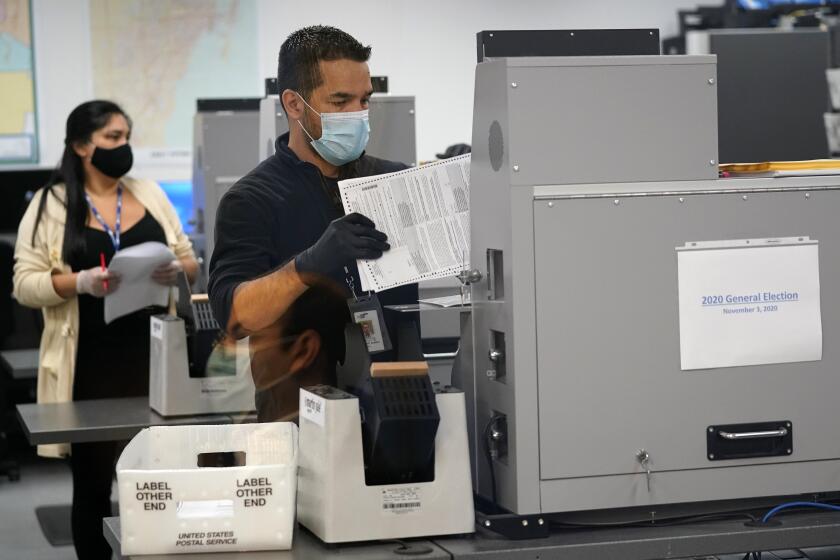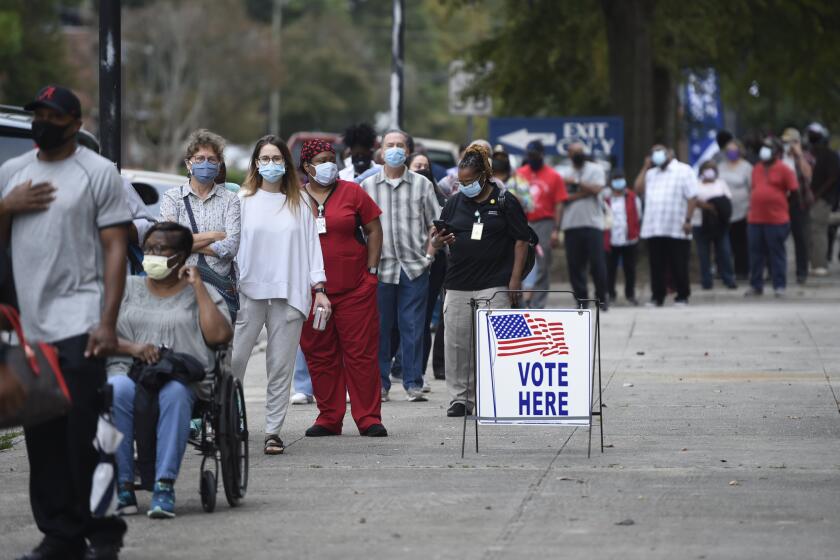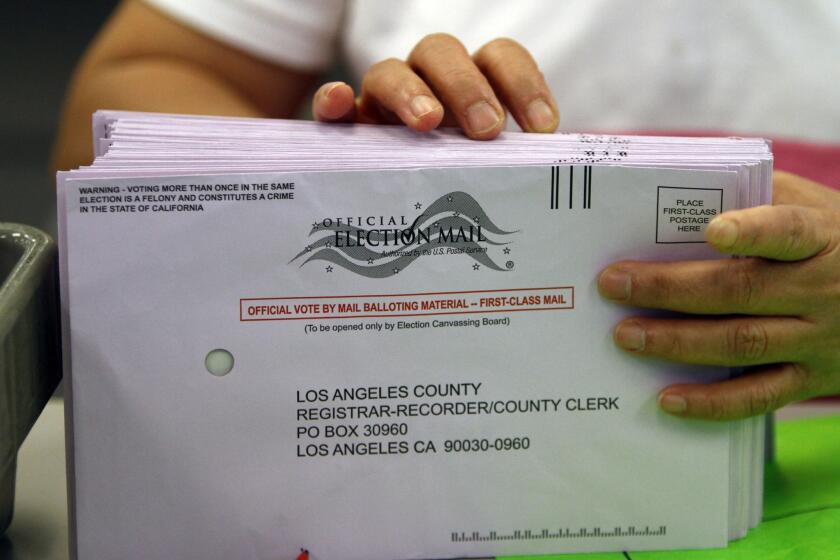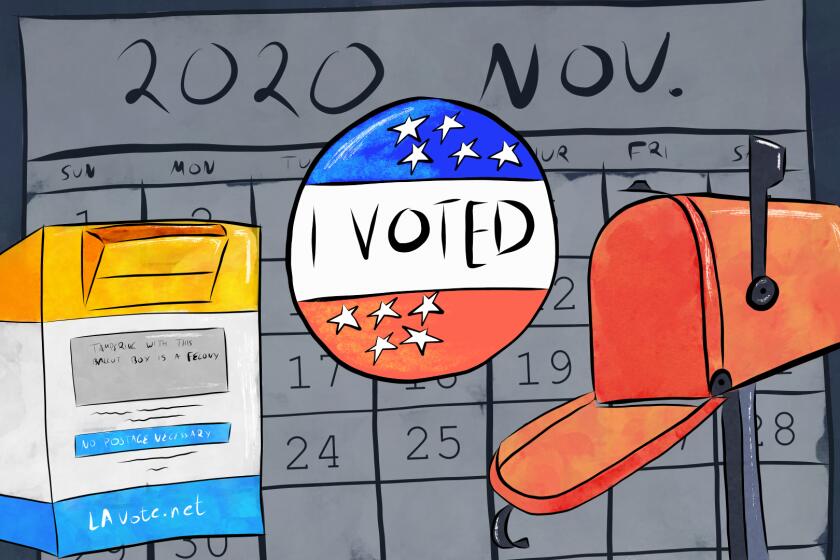When will we know the winner of the 2020 election? Patience is key

- Share via
While we’re all beyond ready to see this election — and this year — come to an end, don’t be so sure we’ll get that closure Tuesday.
Millions of Americans may have already voted, but there’s an unprecedented amount of mail-in voting that has to be counted and a dizzying array of rules for how that process will work in each state.
Don’t worry, we’ve got you covered.
When will we know the winner?
As Edward Foley, a constitutional law professor at Ohio State University, will tell you, that’s everyone’s “zillion-dollar question.”
But it’s hard to say for a variety of reasons, including the fact that a record-breaking number of voters are taking advantage of expanded mail voting options.
Each state has different rules regarding when election workers are allowed to start preparing ballots for counting. Before a voter’s selections are tabulated, election officials need to verify the signatures on ballots, open them, flatten them out and scan them through equipment
Key battleground states like Florida, Arizona and North Carolina are expected to count most of the ballots by election night, if not soon after. (If President Trump loses Florida and North Carolina, it’s likely all over).
States like Pennsylvania, Michigan and Wisconsin — which went for Trump in 2016 — could take days.
Election 2020: These states will probably decide if Joe Biden or President Trump wins the race. And their absentee ballot laws could determine when we find out.
Then there’s the issue of when ballots are due. At least five battleground states will accept ballots after Nov. 3 if they’ve been postmarked on or before that day. Others require absentee ballots to be received by election night. And there have been court battles, with a number of Republican legislatures and governors aiming to stop expansions meant to ease voting amid a pandemic, and more lawsuits filed Tuesday.
So if you’re looking for the legal answer, Foley said, “we officially have a president-elect when Congress meets on Jan. 6 to receive the electoral votes from the states.”
“Of course, none of us want to wait until Jan. 6 for the answer,” he said.
Once the presidential votes are in, it’s a race against the calendar to get them counted. What happens before and after safe harbor day?
Why are there so many different rules for counting ballots?
Because there’s no national standard.
Congress has the constitutional authority to pass uniform laws for federal elections, but have chosen “largely not to exercise that power,” according to Foley.
“For historical and cultural reasons, there’s been a strong understanding of letting elections be conducted pursuant to state law,” he said. “That’s just our tradition.”
As a result, you have states — like Arizona, Florida and North Carolina — that allow ballot processing weeks ahead of Nov. 3. And then there are states — like Pennsylvania, Wisconsin and Michigan — whose laws prohibit ballot preparation before election day.
How are states called?
Americans rely on TV networks such as ABC, CNN, Fox, NBC and CBS, as well as news agencies like the Associated Press to project winners in each state. These aren’t based on random guesses, but on actual polling data and vote counts.
Every major TV news organization has a “decision desk,” where statisticians and political analysts look at historical voting trends, polling data and the actual vote count as it comes in before calling a winner in each state.
In 2017, Fox News and the Associated Press broke away from the consortium of news outlets that pool resources to do exit polling during elections — finding the in-person questioning at polling locations to be less reliable.
This year, Fox News will test its Voter Analysis System, a survey developed with the Associated Press and the National Opinion Research Center at the University of Chicago, for the first time in a presidential race. The survey, compiled from telephone and internet responses, queries more than 100,000 people on their candidate preferences.
Don’t forget, though, that these are not final results from states but unofficial network projections. (Shout out to the awkwardness of 2000 when networks had to retract the call for the winner in the presidential election between Vice President Al Gore and Texas Gov. George W. Bush).
The cable news network is ready for a long night — and maybe a couple of extra days too — after the presidential election results start coming in on Nov. 3.
Wait, back up. What happened in 2000?
I was 8 at the time, so I understand your memory lapse.
That year, networks declared Gore the winner, then retracted. They then declared Bush the winner, and again had to take it back.
After seeing the projections announced on television, Gore called Bush to concede the election. But by 3:17 a.m. Eastern, the Florida secretary of state’s website showed Bush’s lead shrinking to 565 votes. Gore called again to rescind his concession.
What came next was several weeks of legal and political skirmishing over spoiled ballots, military votes, proposed recounts and assorted other election minutiae. (Remember butterfly ballots and hanging chads?) The U.S. Supreme Court ultimately voted 5-4 in favor of stopping a statewide Florida recount — delivering the electoral college victory, and thus the presidency, to Bush. Gore ended up winning the popular vote.
TV networks are still haunted by how botched Bush v. Gore election night coverage set in motion the Florida recount crisis. Can it happen again?
What are some key counties to watch?
Look for Obama-Trump counties (places that were blue in ’08 and ’12 and then flipped red). Some examples: Erie and Luzerne counties in Pennsylvania and Macomb in Michigan.
Pay attention to the suburbs, which are always a battleground in presidential races. Maricopa County in Arizona includes Phoenix but also a lot of sprawling suburbs. Republicans used to have a lock on this county, but demographic changes and anti-Trump sentiment put it (and the state) in play.
And, possibly most importantly, in Florida keep an eye on Duval, Miami-Dade and Pinellas counties. Democratic nominee Joe Biden will need to come out of Miami-Dade County with at least 250,000 votes, according to Democratic pollster Tom Eldon.
“It isn’t necessarily a swing county, it isn’t competitive, but it’s the most critical county apart from Broward,” Eldon said. “You want to watch turnout and watch margin.”
It would be difficult for Trump to win the state if he doesn’t carry Pinellas County, Eldon said.
And if Trump loses Florida?
“It has the potential to be a game-over state,” Eldon said.
As the presidential election nears, Democrats and Republicans are targeting Florida’s other Latino voters, not just Cuban Americans and Puerto Ricans.
What’s this ‘red mirage’ people are talking about?
The “red mirage” refers to an election-night count of in-person votes that would suggest that Trump has won — even though there are still millions of votes for Biden that need to be tabulated.
To explain the “red mirage,” let me throw out another couple of words: “blue shift.”
The blue shift is a phenomenon that’s developed over the last couple of decades, wherein the secondary count of ballots (such as mail and provisional) that can’t be completed on election night “tends to be more favorable to Democratic party candidates,” Foley said.
Because of COVID-19 and the rhetoric over vote by mail, there’s a belief that Republicans are more likely to cast ballots in person on election day, whereas Democrats will send in their ballots.
“There’s been some speculation that we can see preliminary results on election night look more red in multiple states — and that’s the red mirage — only to be overcome, perhaps, by the blue shift,” Foley said.
But the reality of that is more complicated. Because of a number of Democratic voters who have tried to vote early, those could be some of the first returns on Nov. 3 creating a “blue shift” early on with a “red shift” coming later.
Moral of the story: Don’t count your chickens — be they red or blue — before they hatch.
What happens if Trump declares victory?
Then that’s that.
Just kidding!
There is no requirement that a winner be known election night, and states do not finalize results that night. But that hasn’t stopped Trump from calling for results to be finalized Nov. 3, even before all the votes are counted.
“It would be very, very proper and very nice if a winner was declared on Nov. 3 instead of counting ballots for two weeks, which is totally inappropriate,” Trump said.
It might be nice, experts said, but counting every vote is not inappropriate — it is, in fact, kind of the point.
Trump has complained for months about mail voting, making the unsubstantiated claim that there are “big problems and discrepancies with Mail In Ballots.” Experts say there is no evidence of widespread fraud in absentee voting, but the president has said repeatedly that the election will be “rigged” — a claim he also made in 2016.
We’ll be tracking ballot rejection data during the 2020 election as they are made available across the country. We’d like to hear from you.
Critics believe Trump is aiming to delegitimize the results of an election he might lose, including a scenario in which he is ahead on election night, when millions of mail ballots have yet to be counted.
But, Foley stressed, “the only thing that can exist on election night are preliminary results.”
“Whether it’s the president or anybody else, it’s just inaccurate to think that you could have an answer on election night that’s an official, legal answer,” Foley said. “What the candidates say doesn’t have any legal status ... the legal process will go about counting the ballots pursuant to law.”
See you on Jan. 6, I guess!
Times staff writer Melanie Mason contributed to this report.
More to Read
Get the L.A. Times Politics newsletter
Deeply reported insights into legislation, politics and policy from Sacramento, Washington and beyond. In your inbox twice per week.
You may occasionally receive promotional content from the Los Angeles Times.


















